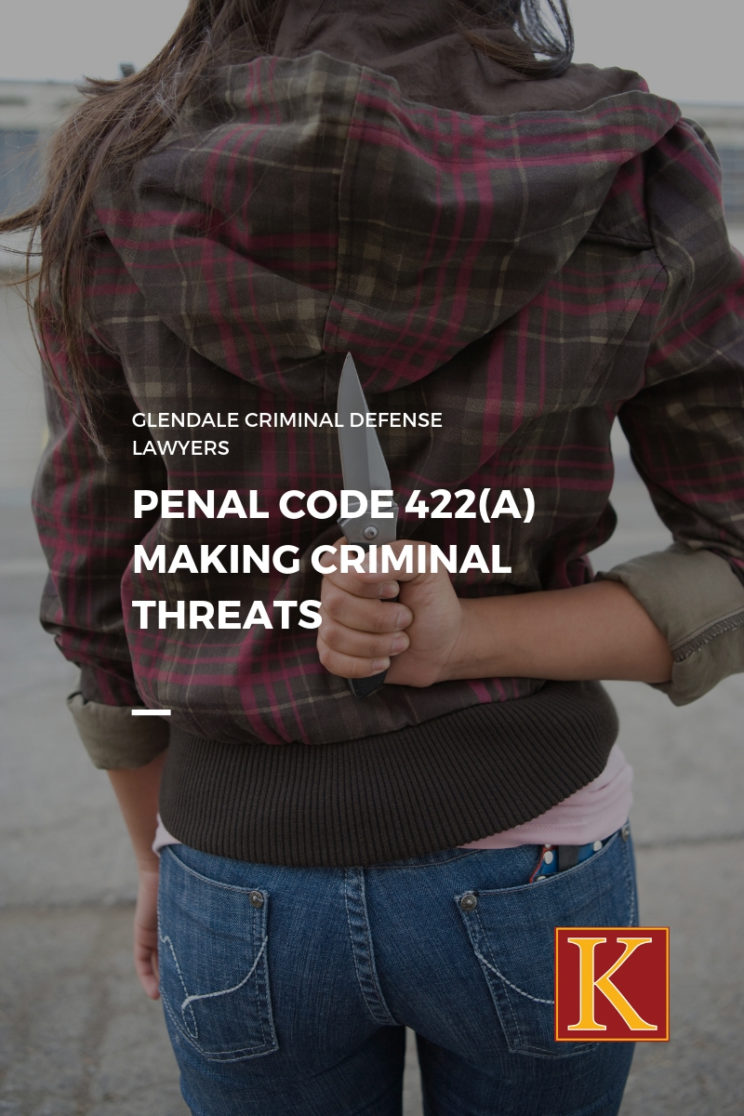California Penal Code 422(a) prohibits any person who intentionally threatens to commit a crime that will result in great bodily injury or death to another, with the specific intent that the statement is to be taken as a threat, even if the person does not have actual intent to carry it out. Previously this offense was called “terrorist threats,” though it can include any threats of harm or violence.
Elements of Penal Code 422(a) Making Criminal Threats
Prosecutor must establish the following elements for proving that the defendant is guilty of making criminal threats:
- Defendant intentionally threatened to illegally cause great bodily injury or kill another person
- Defendant made the threat in person, in writing, or by electronic means. Threats might be expressed through a telephone call, a computer, a video recorder or a text.
- Defendant intended that his statement be assumed as a threat
- The threat was so immediate, clear, specific and unconditional that it communicated to another person immediate prospect that it would be carried out
- Another person was reasonably feared for his safety or for the safety of his immediate family.
“Intention” Element in Making Criminal Threats Charges
The intention to hurt, injure or kill another person is the most important element of the offense. Even if defendant did not have intention to commit the crime, just threatening to cause a serious injury or to kill will be considered enough for being charged with the crime of criminal threat.
“Fear” Element in Making Criminal Threats Charges
Another important element of the crime is fear. According to the law for convicting defendant of criminal threat the victim should be placed in an actual fear and believe that the threat is credible. There should be no criminal threat charges in case the victim never showed any fear or did not appear to be scared.
Conditional and Empty Threat
Though according to Penal Code Section 422 a threat must be “so unequivocal, unconditional, specific and immediate as to convey to the person threatened”, still some specific empty or conditional threats can be qualified as criminal offenses.
To be considered a conditional threat, a threat should be formulated to reflect a certain condition. Conditional threats are considered criminal threats when there is a clear intent and possibility of performing them in case the victims doesn’t meet the stated conditions. For example a threat to kill a person after getting out of prison is a conditional threat.
California Blackmail and Extortion Laws
Under extortion laws conditional threats can be identified as a blackmail or extortion, which can increase penalties for criminal threats.
The empty threats are those ones that the person who is giving them does not intend to perform them but wants to make the victim scare. But in the face of the criminal threats prosecution, it’s irrelevant whether or not the individual has real intention to perform the threat. It is only important that a person conveys the threat in a credible manner so that the victim reasonably believes in it.
Legal Defenses to California Penal Code Section 422(a) charges
Some legal defenses to California Penal Code Section 422(a) charges include the following
Unreasonable Threat Defense
In case the victim feels or does not feel threatened but the fear is unreasonable, then the defendant should not be considered guilty of this offense. Threat must be real and reasonable with the possibility to take place. So if it was unreasonable to perform the threat under certain circumstances it doesn’t important whether the victim actually feared a threat or not.
False Accusation Defense
False accusation takes place when defendant is charged of a crime in a dishonest manner. Some people who are spiteful, angry or vengeful are able to falsely accuse another one for punishing him. Usually this kind of situation appears when the threat was verbal with no written or electronic evidence.
The Victim was Not Feared Defense
Fear is an important element in this crime and in case the defendant’s threat didn’t place the victim in fear then there is no criminal threats violation.
Penalties for California Penal Code 422(a) Making Criminal Threats
Penalties for violating California Penal Code Section 422(a) can be charged as a misdemeanor or felony. Under Penal Code Section 422 PC criminal threat is considered a wobbler and can be charged as either a misdemeanor or a felony, depending on the case circumstances and the defendant’s criminal history.
California Penalties for a Misdemeanor Making Criminal Threats Conviction
Penalties for Penal Code 433(a) Making Criminal Threats for a misdemeanor conviction are the following:
- Up to one year in a county jail
- A fine up to $1,000
California Penalties for a Felony Making Criminal Threats Conviction
Penalties for Penal Code 433(a) Making Criminal Threats for a felony conviction are the following:
- Up to three years in California state prison
- A fine up to $10,000
The defendant will receive additional and consecutive one-year in the state prison in case he used a dangerous or deadly weapon for communicating the threat.
Three Strikes Law
Under California’s Three Strikes Law this offense is a strike and can be used to enhance the penalties on future convictions. The defendant must serve at least 85% of his sentence before he will be eligible for release on parole.
Glendale Criminal Defense Lawyer
If you are a loved one has been charged with violating Penal Code 422(a) Making Criminal Threats contact our Glendale criminal defense lawyer at KAASS Law today at (310) 943-1171 for a free consultation.

